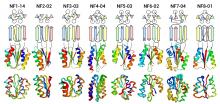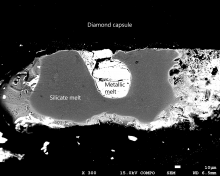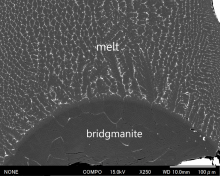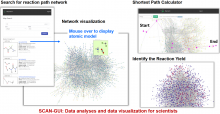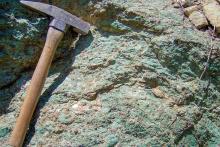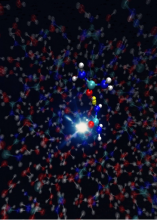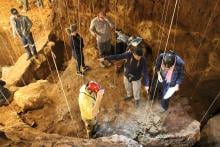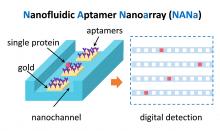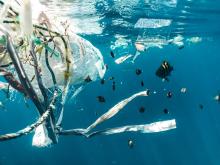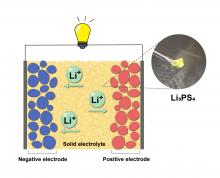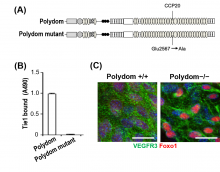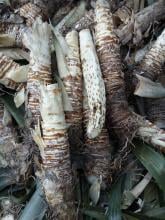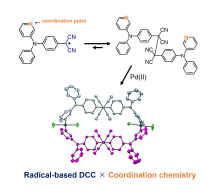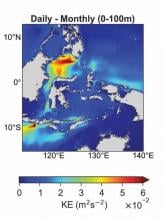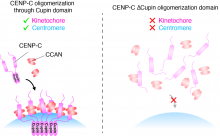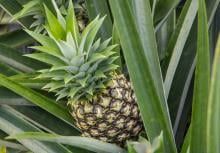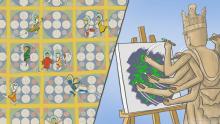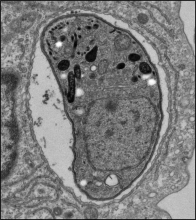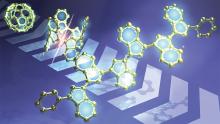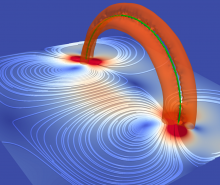Science
News
11 Jul 2023
The entire biosynthetic pathway of actinopyridazone has been unveiled, revealing that an unprecedented carrier protein-mediated ring-forming step is key to its synthesis.
06 Jul 2023
The composition of the Earth’s earliest atmosphere
06 Jul 2023
How have the atmosphere and mantle oxidation state of the Earth changed?
05 Jul 2023
Researchers at Kanazawa University report in Science Advances high-speed atomic force microscopy experiments that show the structural and chemical changes in an enzyme thought to play a vital role in modulating the strength of neural connections.
04 Jul 2023
A new method for connecting neurons in neuromorphic wetware has been developed by researchers from Osaka University and Hokkaido University. The wetware comprises conductive polymer wires grown in a three-dimensional configuration, done by applying square-wave voltage to electrodes submerged in a precursor solution. The voltage can modify wire conductance, allowing the network to be trained. This fabricated network is able to perform unsupervised Hebbian learning and spike-based learning.
03 Jul 2023
A new online platform to explore computationally calculated chemical reaction pathways has been released, allowing for in-depth understanding and design of chemical reactions.
03 Jul 2023
An international research team has discovered that a subduction zone’s age affects the ability for it to recycle water between the Earth’s surface and its inner layers. The more mature the subduction zone, the bigger the water storage capacity.
29 Jun 2023
New technological development has provided further clues about the origins of life on Earth. An international research group invented an innovative X-ray spectroscopy approach that enabled them to recreate the chemical reactions occurring in liquids at the femtosecond level (a quadrillionth part of a second). They used this to examine ureas—an organic compound that underwent ionization to form some of the building blocks of life.
28 Jun 2023
New findings from a cave in northern Laos add to a growing body of evidence that modern humans arrived in Southeast Asia over 80,000 years ago, tens of thousands of years earlier than previously thought.
28 Jun 2023
A New Approach for Peripheral Annelation of Porphyrinoid
28 Jun 2023
Researchers from Osaka University have revealed the mechanism by which increased signaling through a pathway associated with a molecule called Wnt leads to the development of liver cancer. They identified a gene called GREB1 as a target of Wnt specifically in liver cancer. This gene alters the function of a protein called HNF4α, leading to the development of cancer. They also showed that treatment of mice with antisense oligonucleotides against GREB1 had significant anti-cancer effects.
23 Jun 2023
An international team led by Professor Yan Xu from Osaka Metropolitan University has developed a groundbreaking nanofluidic device, named NANa, capable of stochastically capturing and digitally detecting individual proteins at cellular concentrations. This tool, vital for precision medicine, is designed to handle tiny volumes equivalent to a single cell's contents and can identify single biomolecules even in high-concentration environments. The team plans to conduct further demonstrations using actual cell samples and explore the integration of this tool with AI and biological big data. This research could potentially revolutionize personalized disease prevention and treatment.
22 Jun 2023
Researchers from Newcastle University, led by Dr Kheng Lim Goh, have developed a cost-effective Cellular Automata (CA) model for predicting marine plastic movement. Findings from model predictions align well with traditional particle-tracking models, suggesting its potential as a valuable tool for assessing marine plastic pollution and mitigation strategies.
22 Jun 2023
An international team of researchers revisited the fundamentals of Negative Poisson's ratio structure (NPRS) and investigated its creation using laminated carbon fiber reinforced plastics, a strong and lightweight material. Their objective was to gain a deeper understanding of the process and explore potential applications, aiming to unlock new possibilities and advancements in the field of materials science for sustainability.
21 Jun 2023
Osaka Metropolitan University researchers succeeded, for the first time, in stabilizing the high-temperature phase of Li3PS4—a solid electrolyte material¬¬—thus attaining high ionic conductivity even at room temperature, using a method of rapid heating during its crystallization. This unprecedented achievement is expected to contribute to the development of materials for all-solid-state batteries with higher performance.
19 Jun 2023
A key protein for sperm maturation identified, Understanding gel formation, Urine test predicts organ diseases, A laser drills holes in a graphene film. Plus in our blog - The frogs of Borneo: more than just a race. Read all in the latest Editor's Choice.
19 Jun 2023
Researchers from Osaka University found that the binding of two proteins—Polydom and Tie1—is essential for lymphatic cell migration in the remodeling of lymphatic vessels, which transport molecules around the body. A better understanding of the development and remodeling of the lymphatic system will lead to better therapeutic options for diseases such as lymphedema, which is common in cancer patients and currently has no cure.
18 Jun 2023
A team of researchers from universities in Thailand and Malaysia have collaborated to develop a unique kind of bioplastic sheet that is good for the environment and can decompose naturally. They made this bioplastic sheet using a byproduct of the bromelain industry which used the leftover pineapple stems from agricultural waste. This new type of bioplastic sheet has the potential to be used as single-use packaging material, as an alternative to the use of harmful plastic sheet, contributing to a more sustainable way of doing business and promoting a circular economy.
14 Jun 2023
A physicist from the University of the Philippines – Diliman College of Science National Institute of Physics (UPD-CS NIP) led a team of researchers in pioneering a way to make a special kind of “dark” matter that can’t be observed using standard laboratory methods.
12 Jun 2023
Tam Pà Ling, a cave in northern Laos, reveals new secrets about our earliest human journeys from Africa through to Australia.
12 Jun 2023
Osaka Metropolitan University scientists synthesized a novel molecule by combining dynamic covalent reactions based on organic radicals and coordination reactions. They found that the two types of reactions do not inhibit each other. Their results suggest the possibility of synthesizing materials by combining different types of reactions, which is expected to lead to the construction of structures that have never existed before.
09 Jun 2023
Water from the Pacific Ocean flows into the Indian Ocean via the Indonesia Archipelago thanks to a vast network of currents that act as a conveyor belt, transporting warmth and nutrients. Currents can sometimes form circular motions and these are known as eddies. An international group of researchers has modeled the impacts of eddies on the currents that carry water from the Pacific Ocean to the Indian Ocean.
08 Jun 2023
A team led by researchers from Osaka University elucidated a molecular mechanism that is crucial for separating genetic material into daughter cells during cell division. A protein called CENP-C is part of a complex called the kinetochore, which supports the movement of chromosomes. Two portions of CENP-C, the CCAN-binding domain and Cupin domain, are needed for CENP-C to function. The Cupin domain repeats itself through oligomerization, which is essential for proper CENP-C function.
07 Jun 2023
Scientists from Thailand, France and Singapore have conducted groundbreaking research using both tiny cellulose nanofibers (CNF) and long pineapple leaf fibers (PALF) to create stronger materials. They added varying amounts of CNF to epoxy and found that 1% CNF greatly increased impact strength. PALF-epoxy composites showed significant flexibility and strength improvements. Combining CNF and PALF resulted in a remarkable increase in impact strength. The findings could revolutionize stronger material development.
06 Jun 2023
Ultrafast fluorescent imaging technology brings the molecular dynamics of living cells into clear view.
05 Jun 2023
Researchers from Osaka University developed an in vivo CRISPR screen to analyze factors affecting Toxoplasma gondii fitness in healthy and immunodeficient mice. Mice were infected with Toxoplasma containing CRISPR libraries that targeted specific genes; genetic sequencing was then performed to identify which genes are important to fitness. The genetic screen clarified the contributions of host genetics and parasite genetics and can contribute to the development of strategies for toxoplasmosis treatment and prevention.
01 Jun 2023
Fragments of spherical ‘Buckyball’ molecules have stable electron-accepting ability with great practical potential.
01 Jun 2023
Tests could soon identify patients who will respond well to the available treatment for chronic myeloid leukaemia and those who will be resistant to it—which could improve their chances of survival.
31 May 2023
Osaka Metropolitan University scientists investigated numerically the interaction between a quantized vortex and a normal-fluid. Based on the experimental results, researchers decided the most consistent of several theoretical models. They found that a model that accounts for changes in the normal-fluid and incorporates more theoretically accurate mutual friction is the most compatible with the experimental results.
Events

30 Jan 2013
The International Conference for Young Chemists (ICYC) is a biennial conference organised by the postgraduate students of the School of Chemical Sciences, Universiti Sains Malaysia with the aim to gather local and international postgraduate researchers to create interaction and networking in the field of Chemistry.

15 Nov 2012
The Irago Conference 2012 (Asia-Pacific Interdisciplinary Research Conference 2012) will be held November 15-16, 2012 in Irago, Aichi prefecture, Japan.

02 Dec 2012
The Joint International Semantic Technology Conference (JIST) is a regional federation of Semantic Technology related conferences. JIST aims to bring together researchers in the Semantic Technology research community and related technologies to present their innovative research results or novel applications of semantic technologies.

08 Dec 2012
2012 International Conference on Information Technology and Software Engineering (ITSE2012) will be hosted by Beijing Jiaotong University in Beijing during December 8-10, 2012.
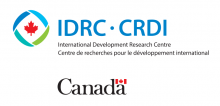
22 May 2012
The lecture entitled "Dry Area Agriculture: A Challenge that can be Overcome" is given by Mahmoud Solh, Director General of the International Center for Agricultural Research in the Dry Areas. If you can’t join in person, there is a live webcast too (link below)

16 Dec 2012
CJP is set to hold Global Algae Biodiesel World programme 2012 from December 16-17, 2012. CJP’s Global Algae Biodiesel World 12 focuses on the entire algae production from lab to scale. Topics are carefully selected to cover the Biology, Engineering, Marketing and Financial aspects of algae commercialization.

14 Oct 2012
The aim of the conference is mainly to report and discuss the most recent topics in computational physics and its applications to research and industry. It treats with particular care also issues related to education in developing countries without enough infrastructure for computation.

11 Jul 2012
IEEE/ASME International Conference on Advanced Intelligent Mechatronics

06 May 2012
An IEEE Region-4 sponsored conference, the 2012 IEEE-EIT, is hosted by Indiana University-Purdue University Indianapolis (IUPUI) and the Central Indiana Section of IEEE (CIS-IEEE).

13 May 2012
The Centre for Science & Technology of the Non-Aligned and Other Developing Countries (NAM S&T Centre) announces the organisation of a 4-day International Workshop on ‘Science and Technology Diplomacy For Developing Countries’ with the Center for Innovation and Technology Cooperation (CITC).
04 Jun 2012
National Institute for Materials Science (NIMS) is pleased to announce “NIMS Conference 2012” to be held from June 4 to 6 2012. The theme is “Structural Materials Science and Strategy for Sustainability - Back to the Basics“

10 Jul 2012
Engineering Conference (ENCON) is the
flagship conference for Faculty of Engineering Universiti Malaysia Sarawak. Currently, the issues of green technologies and sustainable development have been the key focus in the engineering
field. Therefore, the theme for ENCON 2012 is Engineering Towards Change - Empowering Green Solutions.

19 Mar 2012
Come 19 - 22 March 2012, the annual BioPharma Asia Convention 2012 will take centre stage, providing a platform for the biopharma industry to find the right partners for their business needs at Marina Bay Sands, Singapore.

13 Mar 2012
Ottawa, Canada - Carlos Pérez del Castillo, chair of the CGIAR consortium board, will be at Canada’s IDRC March 13 to discuss the importance of renewing Canada's commitment to agricultural research.

26 Mar 2012
Public and private partnerships in agriculture are gaining importance. Yet little is known about how they work or how to improve them. To understand this emerging trend, Canada's International Development Research Center (IDRC) is hosting a conference in partnership with the Syngenta Foundation for Sustainable Development.

13 Mar 2012
The International Development Research Center (IDRC) is hosting a public lecture by Carlos Pérez del Castillo, who will speak about the role of research in achieving food security.
29 Feb 2012
The MANA International Symposium, jointly held with International Center for Young Scientist (ICYS) is organized once a year to disseminate the research results of MANA and ICYS to a wide audience.

16 Feb 2012
The Annual Meeting is one of the most widely recognized pan-science events, with hundreds of networking opportunities and broad global media coverage. An exceptional array of speakers will gather at the 2012 AAAS Annual Meeting from 16-20 February in Vancouver, B.C.

18 Feb 2012
Three researchers supported through the Atlas of Islamic-World Science and Innovation project will present their findings at the 2012 annual meeting of the American Association for the Advancement of Science (AAAS), to be held February 16-20 in Vancouver, Canada.

22 Aug 2012
In the Year 2012, Prince of Songkla University is given the honor to host this 10th International Conference on Membrane Science and Technology after Nanyang Technological University, Singapore in 2011. The theme for this year's conference is "Membrane for Sustainable Energy & Environment".

14 Feb 2012
Seminar which aims to production of niche furniture products using alternative resources.
17 Feb 2012
In this symposium, advancement of R & D especially on renewable electrical energy sources and structural materials for seismic safety using nanotechnology will be reviewed.

15 Feb 2012
International Food and Agricultural Congress which will be held from February 15 to 19, 2012 in Antalya, Turkey. The organizers of the congress are Turkish Agriculture Federation and Middle East Technical University Food Engineering Department

05 Sep 2012
The 5th Global Jatropha 3.0 Integrated Nonfood Biodiesel Farming & Technology Training Programme is dedicated to multifeedstocks for building a sustainable biodiesel industry and is designed to educate all stakeholders about critical issue of availability of right feedstock at right cost to make biodiesel a long-term business opportunity

21 Nov 2011
TWAS, the academy of sciences for the developing world, will hold its 22nd General Meeting in Trieste, Italy, on 21-23 November. More than 250 people from 30 countries are expected to attend.

14 Nov 2012
The International conference on advances in plant sciences will be held from at Empress Hotel, Chiang Mai, Thailand. The main objective of the Conference is to showcase advances in botanical research and conservation of plants across the globe.

12 Oct 2011
This exhibition showcases latest research and products on ceramic technology, with the theme of “Ceramics: driving forward green & life innovation”. It will be held in Tokyo, from 12th to 14th October 2011

26 Mar 2012
The Conference is gathers major water and energy utilities representatives, financiers, environmental specialists, and international experts to discuss all aspects of water resources development. It will be held in Chiang Mai, Thailand, from 26th – 27th March 2012.
Giants in history
Turkish astrophysicist Dilhan Eryurt (29 November 1926 – 13 September 2012) conducted research on how the sun affects environmental conditions on the moon.
Chinese biochemist Chi Che Wang (1894 - 1979), one of the first Chinese women to study abroad, advanced to prominent research positions at American institutions including the University of Chicago and the Northwestern University Medical School.
Ruby Sakae Hirose (1904 – 1960) was a Japanese-American scientist whose research contributed significantly to our understanding of blood clotting, allergies and cancer.
Chinese electron microscopy specialist Li Fanghua (6 January 1932 – 24 January 2020) facilitated the high-resolution imaging of crystal structures by eliminating interference.
Sálim Moizuddin Abdul Ali (12 November 1896 – 20 June 1987), commonly referred to as the Birdman of India, was the first person to conduct systematic surveys of birds from across India.
Haisako Koyama (1916 – 1997) was a Japanese solar observer whose dedication to recording sunspots – cooler parts of the sun’s surface that appear dark – produced a sunspot record of historic importance.
Michiaki Takahashi (17 February 1928 – 16 December 2013) was a Japanese virologist who developed the first chickenpox vaccine.
Toshiko Yuasa (11 December 1909 – 1 February 1980) was the first Japanese female physicist whose research on radioactivity shed light on beta decay – the process in which an atom emits a beta particle (electron) and turns into a different element.
Angelita Castro Kelly (1942-2015) was the first female Mission Operations Manager (MOM) of NASA. She spearheaded and supervised the Earth Observing System missions during its developmental stage.
Malaysia’s first astrophysicist, Mazlan binti Othman (born 11 December 1951) was instrumental in launching the country’s first microsatellite, and in sending Malaysia’s first astronaut, Sheikh Muszaphar Shukor, into space.
Known as Mr. Natural Rubber, chemist and researcher B. C. Shekhar (17 November 1929 – 6 September 2006) introduced a number of technical innovations that helped put Malaysia’s natural rubber industry on the world map.
Shinichiro Tomonaga (31 March 1906 – 8 July 1979), together with Richard Feynman and Julian Schwinger, was awarded the Nobel Prize in Physics in 1965, for their contributions to advance the field of quantum electrodynamics. Tomonaga was also a strong proponent of peace, who actively campaigned against the proliferation of nuclear weapons and promoted the peaceful use of nuclear energy.
South Korean theoretical physicist Daniel Chonghan Hong (3 March 1956 – 6 July 2002) achieved fame in the public sphere through his research into the physics of popcorn.
Japanese chemist Kenichi Fukui (4 October 1918 – 9 January 1998) was the first Asian scientist to be awarded the Nobel Prize in Chemistry. Together with Roald Hoffman, he received this honour in 1981 for his independent research into the mechanisms of chemical reactions.
Chinese palaeontologist, archaeologist and anthropologist Pei Wenzhong (January 19, 1904 – September 18, 1982) is regarded as a founder of Chinese anthropology.
Physicist Narinder Singh Kapany (31 October 1926 – 4 December 2020) pioneered the use of optical fibres to transmit images, and founded several optical technology companies. Born in Punjab, India, he worked at a local optical instruments factory before moving to London for PhD studies at Imperial College. There, he devised a flexible fibrescope to convey images along bundles of glass fibres.
Japanese physicist Ukichiro Nakaya (1900-1962) made the world’s first artificial snowflakes. He started his research on snow crystals in the early 1930s at Hokkaido University, where there is an unlimited supply of natural snow in winter. By taking over 3,000 photographs, he established a classification of natural snow crystals and described their relationship with weather conditions.
The field of solid-state ionics originated in Europe, but Takehiko Takahashi of Nagoya University in Japan was the first to coin the term ‘solid ionics’ in 1967. ‘Solid-state ionics’ first appeared in 1971 in another of his papers, and was likely a play on ‘solid-state electronics’, another rapidly growing field at the time.
Charles Kuen Kao (Nov. 4, 1933 to Sept. 23, 2018) was an engineer who is regarded as the father of fibre optics. His work in the 1960s on long distance signal transmission using very pure glass fibres revolutionized telecommunications, enabling innovations such as the Internet.
Chika Kuroda (24 March 1884 – 8 November 1968) was a Japanese chemist whose research focussed on the structures of natural pigments.
Motoo Kimura (13 November 1924 – 13 November 1994) was a Japanese theoretical population geneticist who is best remembered for developing the neutral theory of molecular evolution.
Meghnad Saha (6 October 1893 – 16 February 1956) was an Indian astrophysicist best known for formulating the Saha ionization equation which describes the chemical and physical properties of stars.
Sir Jagadish Chandra Bose (30 November 1858 – 23 November 1937) was a scientist and inventor who contributed to a wide range of scientific fields such as physics, botany and biology.
Osamu Shimomura (27 August 1928 – 19 October 2018) was a Japanese organic chemist and marine biologist who dedicated his career to understanding how organisms emitted light.
Subrahmanyan Chandrasekhar (19 October 1910 – 21 August 1995) was an Indian astrophysicist who studied the structure and evolution of stars.
Joo-myung Seok (November 13, 1908 – October 6, 1950) was a Korean butterfly entomologist who made important contributions to the taxonomy of the native butterfly species in Korea.
Mathematician Maryam Mirzakhani (12 May 1977 – 14 July 2017) was the first and only woman and Iranian to date to win the Fields Medal in 2014 for her work on curved surfaces.
Sir Chandrasekhara Venkata Raman (7 November 1888 – 21 November 1970) was an Indian physicist who performed ground-breaking research in the field of light-scattering.
Mohammad Abdus Salam (29 January 1926 – 21 November 1996) was a theoretical physicist and the first Pakistani to receive a Nobel Prize in science.
Srinivasa Ramanujan (22 December 1887 – 26 April 1920) was a math prodigy and widely considered one of India’s greatest mathematicians. Despite having almost no formal training in mathematics, he made substantial contributions to mathematical analysis, number theory, infinite series and continued fractions.
Gopalasamudram Narayanan Ramachandran (8 October 1922 – 7 April 2001) is best known for developing the Ramachandran plot to understand the structure of short chains of amino acids, known as peptides.
Hitoshi Kihara (1893 – 1986) was one of the most famous Japanese geneticists of the 20th century. One of his most significant contributions was identifying sex chromosomes (X and Y) in flowering plants.
Chien-Shiung Wu (31 May 1912 – 16 February 1997) was an experimental physicist who made several important contributions to nuclear physics. Wu worked on the Manhattan Project – a top-secret program for the production of nuclear weapons during World War II and helped to develop a process for separating uranium into U235 and U238.
Meemann Chang (born 17 April 1936) is a Chinese palaeontologist who studied the fossils of ancient fish to understand the evolution of life. By examining fossils, she uncovered new insights on how vertebrates, animals with a backbone, migrated from the sea and became adapted to live on land.
Bibha Chowdhuri (1913 – 2 June 1991) was an Indian physicist who researched on particle physics and cosmic rays. In 1936, she was the only female to complete a M.Sc. degree at the University of Calcutta.
Lin Lanying (7 February 1918 – 4 March 2003) was a Chinese material engineer remembered for her contributions to the field of semiconductor and aerospace materials. Lanying was born into a family who did not believe in educating girls and she was not allowed to go to school.
Japanese geochemist Katsuko Saruhashi developed the first method and tools for measuring carbon dioxide in seawater


